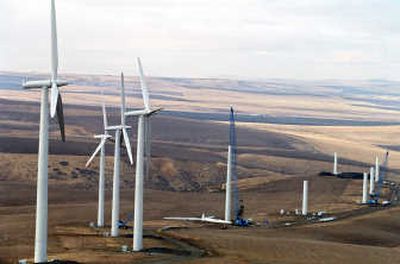BPA’s wind power tops 1,000 megawatts

The Bonneville Power Administration periodically delivered more than 1,000 megawatts of wind energy to the storm-tossed Northwest in November and December, spokesman Doug Johnson said Friday.
At its peak, on Dec. 23 and 24, the agency’s grid transmitted 1,180 megawatts, an amount exceeding the generating capacity of Bonneville Dam and more than enough to meet the electricity needs of a Seattle-sized city, he said.
Wind power has been embraced as a way of meeting growing electricity requirements without building coal or nuclear plants.
About 2,200 megawatts of wind-generating capacity has been constructed in the Northwest, with about 1,400 megawatts connected to the BPA grid, which transmits about 75 percent of the electricity consumed in the region.
Utility officials have approached wind energy cautiously, noting that the need for electricity does not necessarily correspond with periods of high wind. Competition for the best wind sites and turbines has also driven up the cost.
The November and December wind-power deliveries represent an unusually high level of energy production – almost 85 percent – from the wind farms connected to the BPA grid, Johnson said. “That’s pretty good yield from any resource,” he said.
But Johnson added the peaks covered only 7 percent of the period from Nov. 10 to Dec. 27. During 27 percent of that time, windmills produced less than 20 megawatts of electricity.
Avista Utilities has a contract for 35 megawatts of generating capacity from the State Line wind farm on the Washington-Oregon border west of Walla Walla. That energy bypasses the BPA grid.
Steve Silkworth, Avista’s wholesale power manager, said the 35 megawatts is less than 1 percent of the Spokane utility’s total.
Washington law requires all utilities to get their alternative energy portfolios to 3 percent of the total by 2012, ramping up to 15 percent by 2025.
Avista has made offers on two tracts where it may develop its own wind farms, Silkworth said, but the utility has other options available, including further upgrades to its hydroelectric projects on the Spokane and Clark Fork rivers.
Utility-scale wind farms occupy more than 1,000 acres, he said, adding that there are 98 wind-energy projects on the most recent list of proposals for the region.
“It’s the most extensive list I’ve ever seen,” Silkworth said.